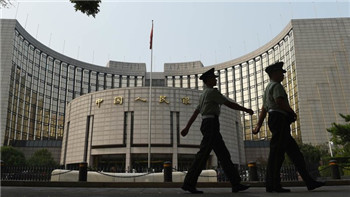(单词翻译:单击)

China’s central bank has embarked on unprecedented measures to stabilise the country’s cratering stock market in recent days, in what some are calling quantitative easing with Chinese characteristics.
最近几天,中国央行采取了史无前例的措施以使中国暴跌的股市企稳,这被部分人称为具有中国特色的量化宽松。
Yet analysts say China’s action more closely resembles emergency actions used by western central banks to stabilise credit markets at the height of the 2008 financial crisis, and differs significantly from the extended bond-buying programmes subsequently rolled out to stimulate the real economy.
然而,分析师表示,中国的举措更类似于2008年金融危机最严重时西方央行为稳定信贷市场而推出的紧急措施,与后来逐步推出的、旨在刺激实体经济的大规模债券购买计划明显不同。
At the height of the crisis, the US Federal Reserve created new lending facilities allowing banks to use mortgage-backed securities and other “toxic assets” as collateral at a time when normal demand for these assets had collapsed.
在金融危机最严重的时候,美联储(Fed)曾创设了新的借贷便利,允许银行把抵押贷款支持证券(MBS)及其他“有毒资产”用作抵押品,而当时,对这类资产的正常需求已经崩盘。
The move by the People’s Bank of China to lend to China Securities Finance Corp to fund stock purchases similarly casts the central bank as buyer of last resort for assets shunned by investors in the open market. Both forms of intervention expand the money supply.
与此类似,在中国央行向中国证券金融公司(China Securities Finance Corporation,简称:证金公司)发放贷款为购股提供资金的过程中,央行也扮演了资产最后买家的角色,而这些资产正是公开市场投资者不愿买入的。上述两种干预手段,都扩大了货币的供应量。
“This is not exactly the US Fed style of QE, but serves the same purpose of stopping market panic and a selling chain reaction through unconventional policies and market interventions,” says Dong Tao, head of Asia ex-Japan economics at Credit Suisse.
瑞士信贷(Credit Suisse)亚洲经济(日本除外)研究主管陶冬表示:“这与美联储式的量化宽松并不完全一样,不过它同样是通过非常规政策和市场干预行为,来达到遏止市场恐慌情绪及阻断抛售行为连锁反应的目的。
“If market conditions do not stabilise, we expect a statement of ‘whatever it takes’ from the Chinese government given that social stability is at stake and financial systemic risks are evident.”
“考虑到这关乎社会稳定,而系统性金融风险也十分明显,我们预计如果市场状况没有稳定下来,中国政府会发出‘不惜一切代价’的声明。”
In the aftermath of the 2008 crisis, as the recovery of real economies in Europe and the US remained sluggish, central banks resorted to a different form of QE: purchases of long-term government bonds. In the eurozone, bond purchases are still ongoing. But this kind of QE is significantly different from what the PBoC has undertaken.
2008年金融危机爆发后,在欧美实体经济复苏依然乏力之际,各国央行曾采取过一种不同形式的量化宽松计划:买入长期国债。在欧元区,债券买入仍在进行当中。不过,这种量化宽松计划与中国央行采取的措施存在显著不同。
Bond purchases by western central banks aimed to stimulate the real economy. By pushing down long-term interest rates, authorities hoped to persuade households and businesses to buy homes and expand factories. By contrast, the PBoC action is aimed squarely at the stock market.
西方央行买入债券旨在刺激实体经济。通过压低长期利率,当局希望能促使居民和企业买房和扩建厂房。相反,中国央行的举措则明确针对股市。
“If the PBoC does buy stocks from investors, that definitely injects money to the real economy and is essentially QE for sure,” said Larry Hu, China economist at Macquarie Securities.
麦格理证券(Macquarie Securities)中国经济学家胡伟俊(Larry Hu)表示:“如果中国央行确实从投资者手中买入股票,这么做绝对会向实体经济注入资金,实质上无疑是一种量化宽松。
“In that case, what’s in PBoC’s mind is to save the market, rather than stimulate the economy as [then-Fed chair Ben] Bernanke did with QE.”
“但中国央行头脑中考虑的是救市,而不是像(时任美联储主席的)本•伯南克(Ben Bernanke)推出量化宽松时那样,考虑的是刺激经济。”
Another difference is the context. Western central banks started buying bonds only when their standard monetary policy tool — short-term interest rates — were already at or near zero, leaving no room for further cuts.
另一个区别在于背景。西方央行是在它们的标准货币政策工具——短期利率——已处于或接近为零、无法进一步下调利率的情况下,才开始买入债券。
The PBoC has cut benchmark interest rates four times since November but the one-year rate, at 4.85 per cent, has room to fall further. In the context of tumbling share prices, however, lower borrowing costs would not persuade investors to buy stocks.
中国央行去年11月以来已经四次下调基准利率,但目前为4.85%的一年期贷款基准利率还有进一步下调空间。然而,在股价暴跌的背景下,借款成本下降无法说服投资者买入股票。
Unlike bond-buying by western central banks, the PBoC is also not taking stocks directly on to its balance sheet, but is instead using CSF as a conduit to inject funds into the market. In practice, the effect is largely the same, economists say, as loans to CSF also create new money while boosting demand for stocks.
此外,不同于西方央行的债券购买,中国央行没有将股票直接纳入其资产负债表,而是以证金公司为渠道向市场注入资金。经济学家表示,实际上二者的效果大体是相同的,因为向证金公司借出资金也创造了新的货币并提振了对股票的需求。
The use of CSF does provide some protection to the PBoC’s balance sheet, however. While the safety of the central bank’s loans to CSF is closely linked to stock prices, CSF has equity capital that could absorb some losses. That would allow CSF to repay loans to the PBoC even if the shares it buys fall in value.
不过,利用证金公司确实给中国央行的资产负债表提供了一些保护。尽管中国央行提供给证金公司的贷款的安全性与股价密切相关,但证金公司拥有可以弥补部分损失的股本。即使证金公司买入的股票价格下跌,证金公司也能够向中国央行偿还贷款。
The bigger quandary for a central bank that finds itself holding stock, whether directly or indirectly, would be how to exit. Just as critics of western governments’ bond-buying worry that developed economies are now “addicted” to QE, so Chinese authorities would confront the risk that once CSF tried to unload the shares it had accumulated, market turmoil would quickly return.
一家央行无论是直接持股还是间接持股,它面临的更大难题都是如何退出。正如批评西方政府债券购买计划的人担心发达经济体现在对量化宽松“上瘾”一样,中国当局也面临着类似的风险:一旦证金公司试图脱手其积存的股票,市场动荡会迅速重现。
China’s central bank has not disclosed the scale of its loans to CSF, saying only that its loans have been “ample”. That makes direct comparisons with western QE difficult. Still, with the mechanism for pumping newly created money into the stock market via CSF now in place, the PBoC is clearly ready to shock and awe if necessary.
中国央行并未披露其向证金公司放出的贷款的规模,只是表示提供的贷款是“充足”的。这使得中国央行的举措与西方的量化宽松难以进行直接比较。不过,既然通过证金公司向股市注入新创造的资金的机制已经就位,中国央行显然已准备好在必要时大显神威。
“The nuclear measure would be for the PBoC to ramp up its liquidity support either via the CSF or directly, making it a de facto QE programme,” Wei Yao, China economist at Société Générale, wrote. “But we are not sure how far the reform-minded central bank will be willing to go in that direction.”
“核心举措将是中国央行通过证金公司加大或直接加大流动性支持,使之成为一个事实上的量化宽松计划,”法国兴业银行(Société Générale)中国经济学家姚炜写道,“但我们并不确定拥有改革思维的中国央行愿朝这个方向走多远。
“If the stock market cannot stabilise soon, the government should be careful not to commit too many resources to this goal.”
“如果股市不能迅速企稳,政府应当谨慎行事,不要向这个目标投入太多资源。”


